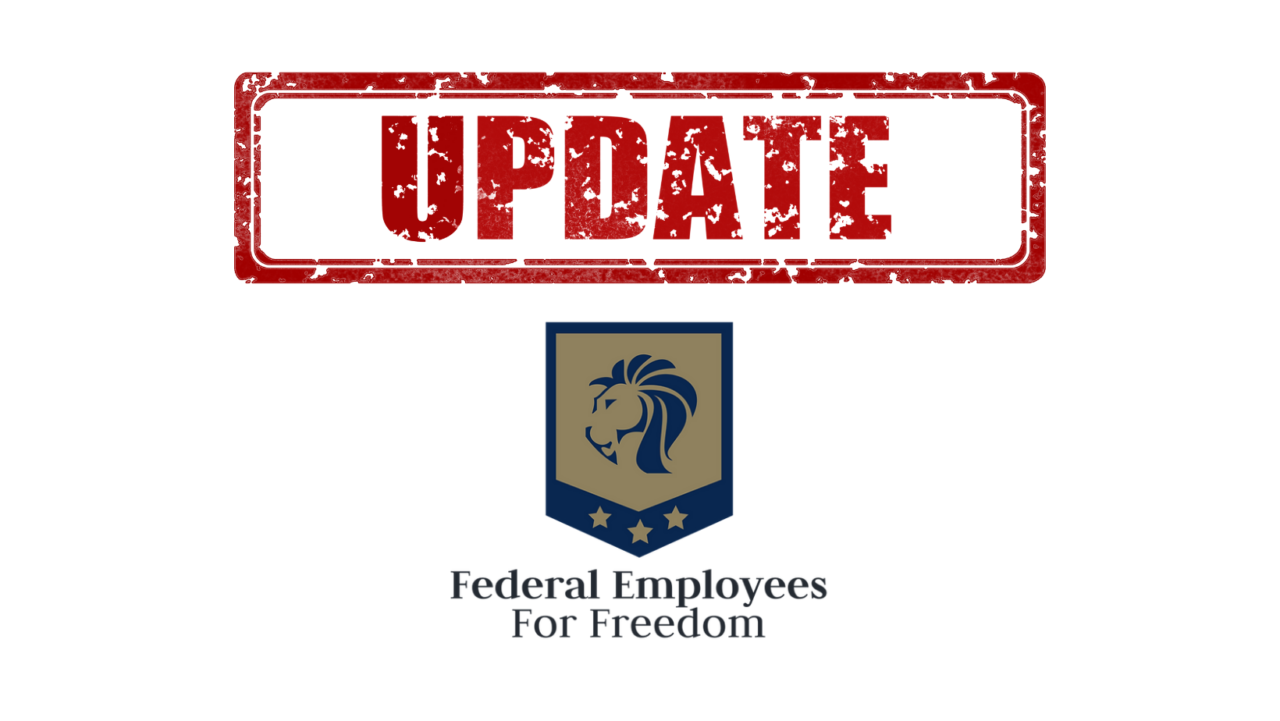
The Fifth Circuit Court of Appeals issued its ruling in the Feds 4 Freedom case, related to the Health Freedom Defense Fund (HFDF)/Federal Employees for Freedom (FEFF) case, against the Biden administrations’ Covid vaccine mandate for federal employees.
The Fifth Circuit endorsed and implemented a nationwide injunction against the executive order issued by President Biden mandating vaccination for all federal employees. That means federal employees now benefit from a nationwide injunction that prohibits the enforcement of the executive order and its vaccine mandate. Thus, federal employees may follow their own conscience and medical needs, declining the Covid vaccine if they choose and will not be subject to discipline for doing so.
HFDF’s legal team considered it might make sense to apply to the judge in our case and request that she rule consistent with the Fifth Circuit opinion but have decided against doing so for several reasons. First and foremost is that the nationwide injunction covers Federal Employees for Freedom and other plaintiffs, so it is likely that such a request might simply annoy the judge who is an Obama appointee, ideological, and apparently completely terrified by the Covid crisis, refusing to come to the courthouse out of fear of getting infected.
Second, even judges who are sympathetic with our cause have simply stayed cases as unnecessary, given the injunctions that are in place that cover and protect our litigants. When an injunction is in place that protects a discrete group of people, courts do not issue additional injunctions because they are duplicative and a waste of court resources as the protection is already in place. As such, we have concluded there is no reason to spend the time and money working on something that will not likely result in anything more than the court’s indicating that there is no reason to take any action, in light of the injunction.
We did assert an additional argument that we believe is stronger than those asserted in the other case because they are procedural.
However, on the same theory that a court will not impose an additional injunction when one is already in place, it is unlikely that our judge is going to want to hear our other theory since it is unnecessary to do so, given the presence of an injunction protecting the plaintiffs and members of FEFF.
The Fifth Circuit opinion is significantly less interesting than we had expected it to be. The bulk of it addresses jurisdiction rather than the merits of the case. There are no grand proclamations of constitutional law that provide us with fodder for our own efforts or permanently address the problem of mandates. The primary question addressed was whether or not the district courts have jurisdiction to hear cases like this. The government argued that they do not because the Civil Service Reform Act (“CSRA”) is the exclusive means of challenging claims like ours that bear on matters affecting the conditions of employment. If that were true, that would mean that federal employees would have to go through an administrative process that would not likely afford the broad relief we are seeking and they would not be entitled to an Article III court trial with all of the protections and gravity that involves.
The government argued for a wildly broad interpretation of the CSRA and the Fifth Circuit (over 30+ pages) indicated that the reading was far too broad and that federal employees have the right to go to district court for relief that does not involve employment action against the employee.
That is the sum of the decision and it gives us very little except the preliminary injunction. It is true that the Fifth Circuit adopted the district judge’s reasoning on the other elements necessary for an injunction, like a belief that the plaintiffs are likely to succeed on the merits, but that goes to the real status here. There is some benefit to us that the Fifth Circuit adopted the trial court’s reasoning on the question of likelihood of success on the merits. But since the case is being sent back to the trial court, a final decision on the merits is yet to come.
It needs to be understood that the ruling is a PRELIMINARY injunction and while it protects federal employees for the time being, it is not the end of the story in terms of protecting them in the future from mandates of this sort.
What we had hoped to do was to get past the pleading stage of litigation and get to a trial on the merits at which a court would not only rule that the mandates themselves were improper but that they are unconstitutional. That was the goal we had hoped to achieve.
Experience of the past few years has been that lawsuits such as ours challenging government mandates have often been shot down at the pleading stage, primarily because judges are often worried more about embarrassment than about doing what is right under the law and, in addition, have bought the mainstream narrative that the crisis was an existential threat to humanity and vaccines were the answer. There are no greater representatives of conventional thinking than judges.
It is important to understand the process to comprehend where we are at this moment. When a plaintiff files suit to prevent someone from doing something to him, he generally seeks a temporary restraining order (“TRO”) to temporarily prevent the wrongdoer from proceeding. The bar is high as at this stage and most litigants do not have sufficient compelling evidence to convince a judge that he should, short of trial, provide relief that prevents someone from doing something otherwise appearing reasonable.
TROs are of limited duration because they represent an order against someone without significant due process. If the plaintiff obtains the TRO, he is then constrained to make a much broader showing that he is entitled to relief. Otherwise, the TRO dissolves. The plaintiff has to produce compelling evidence and sufficient law to suggest that it is likely he will prevail on the merits after a complete trial with witnesses, testimony, and documentary evidence. Again, that is a high bar because its effect is that a court is asked to deprive someone of some power to act without complete due process. The order the plaintiff seeks in that process is a “preliminary injunction.”
A preliminary injunction is just that: preliminary, and it is in place only to hold things in check until a complete trial can be had on the merits. Once there is a trial on the merits, the court either issues a permanent injunction or denies it and dissolves the preliminary injunction. The goal is to get the permanent injunction because, at that point, the defendant is permanently prohibited from doing whatever the plaintiff did not want him to do; in this case, to implement and enforce a mandate for vaccination.
And here is where what has happened at the Fifth Circuit is important: The decision was no more, nor less, than the imposition of an injunction that will stay in place until there is a trial and between now and then there is a lot of litigating to do. There will be discovery and motions and the production of documents and the development of expert testimony for both sides. It is a lot of work and a very, very long road. And, in the end, we may not reach the end of that road.
It also means that while federal employees and FEFF are protected now, there is no guarantee they will be protected after the trial because the plaintiffs might fail at trial, in which case the preliminary injunction will be dissolved and the government will have the power to impose mandates.
The trial on the merits – and that is what we were all hoping would be the result – would involve the court’s taking testimony and dealing with and ruling on the broader issues of constitutionality and our claim that the government never had the power to impose a vaccine mandate.
So, here is the problem: we may never get there and get that answer and that is noted, obliquely, in the opinion. The Fifth Circuit observed in what looked like a throwaway line, that shortly there will be the lifting of all declarations of emergency and that the parties will have to deal with that.
What does that mean? It means that when the emergency declaration expires, the government will likely move for dismissal on the basis that the case is moot since federal employees are no longer subject to discipline for failing to get vaccinated. And it means that there will be no final answer, if the courts dismiss on that basis, which means that the federal government could always do it again the next time there is an epidemic. So, there would be no permanent answer on which federal employees could rely in refusing the next order that comes down the pike.
One point to bear in mind is that if the government moves for mootness in the district court in the Fifth Circuit, that motion will apply only to that case – not to ours. We don’t want to speculate but based on the initial ruling we believe the district court in Texas might be inclined to reject the motion. If the court does grant the motion, the nationwide injunction will be dissolved.
That would mean we would be able to proceed with our case since our plaintiffs would no longer be protected by the injunction.
HOWEVER, an effort to proceed would likely simply draw a motion to dismiss for mootness by the government in our case as well, which, given that our judge is significantly less amenable to our arguments than the district judge in Texas, would likely be granted by her. Then we would have to consider whether to appeal.
There is a doctrine that everyone on our side would argue and that is “capable of repetition yet evading review.” That is a strong doctrine but is seldom imposed. What it means is that even though the current case is moot, the issues are too important to allow them to sit out there unaddressed since the government could do it all over again. So, a court may well go ahead and allow the case to be litigated on the merits in order to achieve a final answer so federal employees will know where they stand in the event of another pandemic crisis.
But courts like to get things off their dockets and generally look for the simplest way to do so which means they will be inclined to rule that these cases are moot since federal employees are no longer under any threat (even though they could be if there were another similar situation) and dismiss them on motion.
While we understand not pursuing the matter further would not be the most satisfying result, we have to keep the victories in perspective. What has been accomplished here as a result of our lawsuit and the others is that thousands of federal employees such as the members of FEFF were able to keep their jobs and refuse to get vaccinated for a sufficient time for the emergency to be lifted. Careers were saved. Pensions were saved. Jobs were saved.
Yes, we would prefer to obtain a final answer in our favor but, short of that, saving FEFF members’ careers and pensions is an important result that would have not been accomplished but for our efforts and those of dozens of other lawyers throughout the nation.
While this may be frustrating to plaintiffs and members of FEFF, we may, yet, get the opportunity to litigate this to a conclusion and get final answers. That remains to be seen. But, for now, it will have to be enough to know that federal employee jobs and pensions are safe, and shortly, the emergency will be lifted and all executive orders that were issued to address it will be void.
This was a big victory, but the opinion was not huge. It only did one thing and that is to clarify that federal employees have the right to file suit against the government and get relief in the courts and are not prevented from doing so because of the Civil Service Reform Act. THAT argument, at least, has been put to rest, for now.
And there is this: sometimes it is better not to get a final answer because the final answer might not be the answer desired. If we lost, then, for all time, the government could impose a vaccine mandate any time there was an international case of the sniffles. The same is true for the other side, as well. They do not know if they have the power to impose such a mandate because there has been no final answer. So, both sides could be disappointed in not having a final answer they want, but both sides would still have all of their arguments and the power to litigate this all over again.
We must all remember the price of freedom is eternal vigilance. The plaintiffs and members of FEFF were courageous and vigilant to take their stand for freedom and because of them Americans are freer today.
And we stand ready to mount the battlements again in defense of our rights if courts decide the cases are moot and dismiss them and the government tries this again. That said, our guess is that the government will be hesitant to implement another mandate because it ran into a buzzsaw of opposition and did not succeed.
The lack of success and widespread opposition to the mandates has embarrassed those behind the mandates. And the kind of people behind the mandates fear embarrassment most of all, so it will serve as a powerful deterrent.
One final note: the fact that the Fifth Circuit adopted the reasoning of the district court that the plaintiffs were likely to prevail on the merits, is important because it means that the Fifth Circuit Court believes we WOULD have won had the case gone to trial. That is reason enough for the government to refrain from trying it again. But it isn’t the final answer.
In lawsuits one can never tell till the end which party has prevailed. That said, we would rather be where we are than where our opponents are. We, at least, have a court of appeals saying that there was a reasonable likelihood that the plaintiffs would prevail on the merits and that we always have the right to a day in an actual court rather than a labyrinthine administrative process that would never be likely to give us the answer we seek. For now, that will have to be enough.














